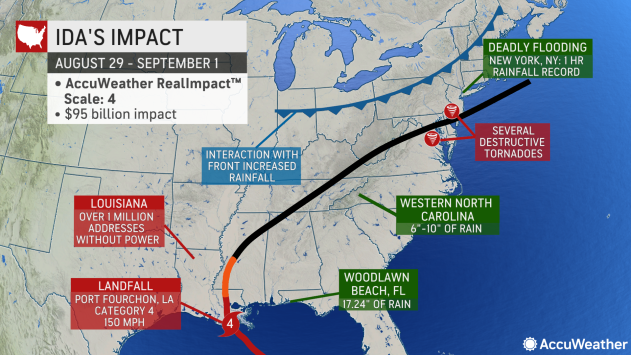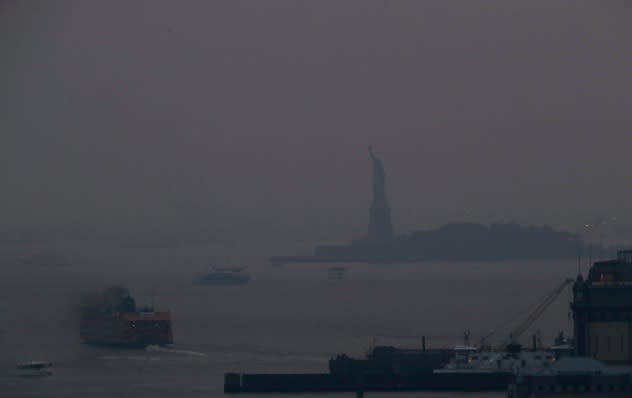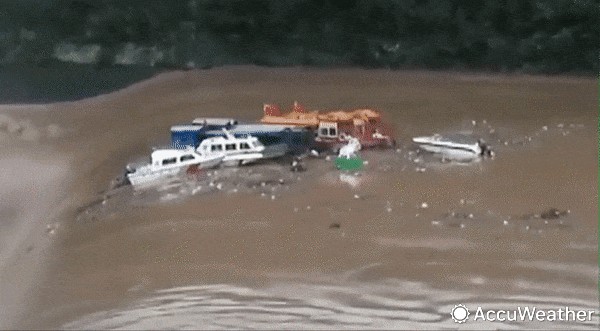Goodbye summer: 11 wild facts about summer 2021
With the passing of the fall solar equinox, the Northern Hemisphere is now officially in the midst of fall and can finally say goodbye to a long and unique summer.
The long summer days left us with beautiful and memorable photos, from pink skies in Milwaukee to an orange haze over the smoky Rockies to a golden evening on the water in Maine, even in summer's waning days. However, before plunging headlong into fall, let's give summer 2021 a proper farewell by looking at the season's wildest weather facts.
The summer of 2021 was notable in many regards, but perhaps nothing stood out more than the number of heat records that were set. A historic heat wave baked the Pacific Northwest in June, setting all-time highs in Portland, Oregon, Seattle, and Lytton, British Columbia. In fact, the 121 F reading in Lytton was the highest temperature ever recorded in Canada. The event was heralded as a "1,000-year event" by NOAA and led to the hottest June ever in the United States.
So-called 1,000-year weather events are those that climate scientists say would've been all but impossible prior to the industrial age and the warming of the climate that has ensued since. As AccuWeather Meteorologist Brett Anderson noted in a blog post, these sorts of rare weather events will become all the more common in the decades ahead if the factors fueling global warming go unchecked.
 |
Death Valley, California, on more than one occasion, came within striking distance of its own world record temperature of 134 degrees Fahrenheit from 1913, hitting 128 F in June. Then, in mid-July, a temperature of 130 F was recorded there as another heat wave roasted the southwestern United States.
Summer 2021 also featured an unusually high number of tropical cyclones impacting the U.S., including six tropical storms and two hurricanes between June 20 and Sept. 22, and seven of made landfall in the United States. The formation of Tropical Storm Rose on Sept. 19, just before the official first day of fall, put the 2021 Atlantic hurricane season at its third-fastest pace on record, only behind the hyperactive 2005 and 2020 seasons.
 |
The strongest storm, Hurricane Ida made landfall in the U.S. as a major hurricane, striking Louisiana as a Category 4 hurricane on Aug. 29. Ida was the seventh-strongest hurricane on record to hit the United States mainland. A severe storm surge devastated the Louisiana coast, and high winds caused prolonged power outages in New Orleans, leading to numerous heat-related fatalities in the city, according to The New York Times. Ida's devastating and deadly impact on the southern Louisiana coast was just the beginning of its rampage.
More than 1,000 miles away, and despite the storm having lost wind intensity, Ida inflicted devastating destruction on the Northeast with flooding rainfall and outbreaks of severe weather that it spawned across the region. The 1,000-year flooding event caused by Ida was amplified by the fact that the areas hit the hardest by Ida in the Northeast had been drenched a week earlier with heavy rain from Tropical Storm Henri, which dumped as much as 14 inches of rain on one part of New Jersey.
Even before Henri began drenching New York City and the surrounding area, a deluge of rain fell at the city's official climate station. During the hour between 10 p.m. and 11 p.m. on Saturday, Aug. 21, 1.94 inches of rain fell in Central Park, which made for the wettest hour in the history of the city, according to the National Weather Service. In total, Central Park tallied more than 8 inches of rainfall from Henri, which arrived the next day.
But that record for the city's wettest hour didn't last long. In fact, it was obliterated less than two weeks later when Ida, no longer a hurricane but a fierce tropical rainstorm, hit New York City. During the hour between 8:51 p.m. and 9.51 p.m. on Sept. 1, 3.15 inches of rain was measured, which set the astonishing new record. All told, Ida dumped 7.19 inches of rain on Central Park, according to the NWS, making the fifth-wettest day in the park's history.
Just a week earlier, extreme rainfall had hit Waverly, Tennessee, on Aug. 21, killing dozens of people. A staggering 17.02 inches of rain fell in McEwen, Tennessee, likely breaking the all-time 24-hour rainfall record for the state. The intense rainfall, which occurred at the same time Henri was causing flooding in Northeast, put rivers well over their record crest. The Piney River at Vernon, Tennessee, crested at 31.8 feet, shattering the river's previous record from 2019 by nearly 12 feet.
Tuscaloosa, Alabama, also endured extreme flooding the week before fall 2021 began, as a result of moisture left over from Hurricane Nicholas -- another 1,000-year event.
Wildfires raged across the western U.S., with the Dixie Fire in California devastating town after town, burning nearly 1 million acres from July to September, the biggest single fire in the state's history. In late August, the large, long-burning Caldor Fire caused evacuations in South Lake Tahoe, California. In the final days of summer, California's famed Sequoia trees were threatened by a wildfire, but the famed 275-foot "General Sherman" tree escaped without harm.
 |
The Staten Island Ferry departs from the Manhattan terminal through a haze of smoke with the Statue of Liberty barely visible, Tuesday, July 20, 2021, in New York. (AP Photo/Julie Jacobson) |
Smoke from the wildfires in the United States and Canada traveled across all the way to the Midwest and Eastern Seaboard over much of the summer, causing vivid sunsets and impacting air quality across vast swaths of the country.
In July, exceptional warmth seeped well into the Arctic Circle in the northernmost parts of Scandinavia -- areas that are typically locked in ice and snow for a large portion of the year. Banak, Norway, reached a high of 94 F (34.3 C) on Monday, July 5, which was a record for the site, according to the Norwegian Meteorological Institute. That reading was flanked by highs of 93 F (33.7 C) on the day before and 89 F (31.7 C) the day after.
Greenland's ice summit recorded its first non-frozen precipitation on record in late August, when rain fell for the first time in recorded history at the station and lost billions of tons of ice during a heat wave. As the heat wave pushed temperatures nearly 70 degrees Fahrenheit above seasonal norms, more than 8 billion tons of ice sank into the ocean on four consecutive days.
Technically still in the summer season, the low-pressure system formerly known as Hurricane Larry brought as much as 8 inches of snow to eastern Greenland on Sept. 12.
Farther south, a dangerous heat wave baked the Mediterranean region of Europe in mid-August, stoking large wildfires in Greece and Turkey that killed at least eight people, including two firefighters. In July, record flooding struck Germany and Belgium, killing hundreds and devastating small towns.
 |
Destroyed houses are seen close to the Ahr river in Schuld, Germany, Thursday, July 15, 2021. |
On Aug. 11, a temperature of 119.8 F in Sicily, Italy, set a new all-time record in Europe -- pending verification by the World Meteorological Organization. Across the Mediterranean Sea, several new records were set in the African country of Tunisia as well. In Tunis, the temperature climbed to 120 F (49 C), setting a new record high temperature for the city, according to Reuters.
On the same day, the mercury surged to 122.5 F (50.3 C) in the city of Kairouan, Tunisia. This was the highest reliably recorded temperature in the country, breaking the previous record of 122.2 F (50.1 C) set in Al Burmah on July 26, 2005.
Repeated heavy rain events in Japan caused flooding in and around Hiroshima as more than 330,000 people were forced to evacuate their homes due to the threat of flooding and mudslides on July 8. Shikano, which is near the southwestern coast of Honshu, received 6.30 inches (160) mm of rain over the course of 24 hours.
A mudslide turned deadly in Atami, Shizuoka, Japan. The mudslide damaged hundreds of buildings and swept up vehicles in its path, killing at least 22 people, according to reporting from The Japan Times.
 |
Boats float downstream and over a waterfall on a raging river in the city of Bazhong. (Newsflare) |
China also saw deadly flooding in mid- and late July, with a 1,000-year storm turning subways and streets into raging rivers across cities across the Henan province. According to the BBC, more than 500 people were rescued from subway systems in Zhengzhou after videos emerged of people struggling to keep their heads above water in submerged subway cars.
 |
Lava from a volcano eruption flows on the island of La Palma in the Canaries, Spain, Thursday, Sept. 23, 2021. Experts say the volcanic eruption and its aftermath on a Spanish island could last for up to 84 days. (AP Photo/Emilio Morenatti) |
A devastating magnitude 7.2 earthquake in Haiti killed more than 2,000 people on Aug. 20, with several strong aftershocks of 5.0 hammering the country. Days later, Tropical Storm Grace dropped torrential rains in the country, hampering rescue efforts and making life miserable for those sheltering in tents after their homes were made unlivable by the earthquake.
The week before fall began, a major volcanic eruption hit the Canary Islands. More than 20,000 small earthquakes preceded the volcano's eruption. The lava flow from the volcano tore through populated areas, forcing thousands to evacuate and destroying hundreds of homes on the island. Ángel Víctor Torres, the president of the Canary Islands, announced that damage on La Palma will total an amount higher than 400 million euros ($469 million).
After being postponed a year due to the coronavirus pandemic, the 2020 Summer Olympic Games in Tokyo had to wrestle with weather concerns. Tropical Storm Nepartak forced the rescheduling of several Olympic events as it approached the Japanese mainland on July 25. Rowing events were rescheduled, and surfers battled choppy and unpredictable waves. A tennis match was also halted as rains from the tropical system fell, and a triathlon was delayed.
 |
This satellite image, captured on July 26, shows Nepartak approaching Japan. (RAMMB/CIRA) |
Tropical Storm Mirinae also drew close to mainland Japan during the Olympics, but it did not make landfall. The storm brought tropical rainfall to Tokyo just before the start of the closing ceremonies.
Mexico, like many places globally, had a hot summer. Mexico recorded its highest August maximum temperature and endured one of the strongest hurricanes to make landfall in the eastern part of the country. Grace hit as a Category 3 storm on Aug 21, killing at least 13 people and causing more than $500 million in damages. Grace caused damaging mudslides and power outages as the storm moved inland.
Worldwide, summer 2021's heat set records as well. NOAA's National Centers for Environmental Information (NCEI) issued a press release detailing how July 2021 "earned the unenviable distinction as the world's hottest month ever recorded."
 |
Land surface temperatures during the day in July 2021 measured by NASA's TERRA and MODIS satellites. |
By an extremely narrow margin, (less than 0.01 of a degree Fahrenheit), the heat this summer exceeded the record heat that occurred during the "Dust Bowl" summer of 1936, when hot and dry conditions baked parts of the Midwest and Canadian Prairies and caused devastating impacts, making this the hottest summer ever in the United States.
Given the global temperatures measured throughout 2021, NOAA said that it is "very likely" that 2021 will finish as the warmest year on record.
For the latest weather news check back on AccuWeather.com. Watch AccuWeather Network on DIRECTV, DIRECTVstream, Frontier, Spectrum, fuboTV, Philo, and Verizon Fios. AccuWeatherNOW is streaming on Roku and XUMO.









